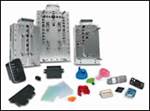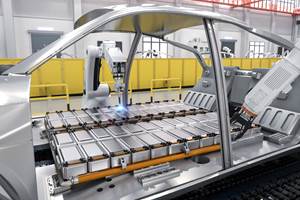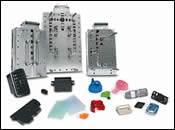Improving a Family Molding Program
Synventive Molding Solutions joins with a leading automotive trim molder to expand the use of complex family molds for interior trim applications while providing consistent quality and a flexible process.
Speed, flexibility and consistent part quality are the buzzwords for staying competitive in the cost-conscious American large automotive plastics molding marketplace.
When an MI-based corporation - a major automotive trim manufacturer - chose to upgrade its hot runner systems, it turned to Peabody, MA-based Synventive Molding Solutions as its partner because of the technological advantage that next generation smart molding systems could offer. Seeking to benefit from the ability to produce automotive trim parts at high speed with exceptional finish quality and part-to-part consistency, the company invested in Synventive Dynamic Feed hot runners to achieve a competitive technical and processing edge. Furthermore, the molder was able to successfully implement a family mold that produces separate and distinct parts, parts that exhibit exceptional dimensional stability and consistency - a target that the company struggled with until a smart molding system was used to process them.
Starting Up
In June of 2000, the entire plastics world invaded Chicago, IL - specifically the McCormick Place - to attend the National Plastics Exposition. At the show, Synventive unveiled the Dynamic Feed smart molding system, creating lots of interest in a hot runner system that brings incredible levels of control and accuracy to the injection molding process. Engineering managers at this automotive trim molder were very interested in the new technology. In fact, they were among the first customers to see a presentation on smart molding, and ultimately ordered five complete systems from Synventive in the summer of 2001.
The Dynamic Feed hot runner system is a proven technology that delivers unprecedented levels of control to the processor, offering molders the ability to individually control the fill and pack rates at each gate of a multicavity or family mold, or at each individual gate in a large multigated mold. The key to the control of this smart hot runner technology is that the control is in the hot runner nozzle, allowing molders to control the entire shot process with a closed-loop, real-time controller. Unlike machine optimization or mold balancing systems that seek to control elements other than the actual injection molding process, smart molding gives processors control of the very heart of the injection molding process.
After running a detailed internal return on investment analysis of the system, the company could see that a smart molding system offered the company a clear competitive advantage. The new technology was ordered on a tight timetable that gave Synventive just six weeks to deliver. In addition to the tight delivery schedule, Synventive needed to train the molder's people in the optimal use and operation of smart molding technology.
Molding Challenges
According to the trim tooling manager at this automotive parts molder, the goal was to gain a speed and quality advantage in the marketplace with a hot runner system that had a quick setup time with excellent part-to-part consistency. The company turned to Synventive for those answers when it initiated this family molding program.
The Michigan firm planned to use the Dynamic Feed systems to help mold automotive instrument panel shrouds, a job that integrated several complicated elements into the mold. Its mold builder, Delta Tooling of Auburn Hills, MI, supplied the family mold for the project. The mold contained fine detailed elements plus a second molding operation to overmold a different color material onto the part. The family mold for the instrument panel shroud featured a small panel accent on the right side and a larger panel accent on the left side, with a cutout for an air conditioner vent. In addition, the shroud has a contrasting color accent molded onto it. The technical issue with the mold was how to manage the three-to-one ratio difference in shot weights for each of the accent panels, a situation where the machine must seal off the part in the mold to create a parting line with the overmolding process.
With the seal-off measuring just three eighths of an inch where normal injection molding standards are typically three inches or more, coupled with the complexity of dissimilar sized parts being molded simultaneously, it was clear that standard hot runner technology was not going to offer the speed and accuracy that the company desired. The molding process to manufacture the instrument shroud is very precise to ensure quality and cavity sizes, plus the seal-off tolerances meant that it was essential for the processor to have finite control of the injection fill and pack profiles of the cycle. This was even more essential due to the seal-off tolerances; any overshot and the entire part would be ruined. Similar to a waffle iron with too much batter in it that spills all over the countertop, the mold seal will blow if the mold is overshot, requiring a very precise injection molding process. The entire process took place in a family mold, also adding to the complexity of the molding process.
Synventive Molding Solutions recommended a Dynamic Feed system based on the need for precision and due to the dissimilar sized accent panels being molded. That ruled out using a more conventional sequential valve-gated system, because of the need to balance the mold parameters and the injection molding process so precisely.
Going Online
Before the program could begin, Synventive and Delta Tooling needed to test the molding process and machinery to assure their client that the hot runner system and the family mold would work as advertised. The two firms tested the systems and mold at Delta's test center, where the two companies had a short learning curve implementing the new smart molding technology and family mold. The focus of the testing was on start-up procedures, which proved to be easily mastered. Moreover, the testing allowed for the complex family mold to be dialed in by the Synventive and Delta technicians, who could adjust the rate of fill and pack pressures needed to create dimensionally stable, top quality parts cycle after cycle. Most importantly, the test site allowed the Synventive team to bring together the injection molding machines, the family mold, the smart molding system and the plastic material suppliers under one roof to get a real world construct of how the program would ultimately come together. All parties at the site were very pleased with the consistency and repeatability of the smart molding process.
Meanwhile, the Synventive team was working overtime to make sure the Dynamic Feed systems would be delivered on time and to specification. The order was met by coordinated efforts in Peabody with the engineering and manufacturing staff. And, although the timing was tight and Synventive and Delta had to put in long hours to make it happen - including training the molder's operators on using the system at the plant - Synventive was able to deliver the systems on time and on-spec to their customer.
Up and Running
Smart molding technology was immediately embraced by the plant personnel. "Exceptional" is how the engineers describe the Dynamic Feed system, noting, "It's a processor controller on steroids."
The quality and repeatability of the system - the driver for purchasing the hot runner system - proved to be exactly what the company desired. While the press speed and cycle times remained mostly the same, the flexibility and the part-to-part quality of the automotive instrument shroud program was something that engineers say is "... a new level of sophistication for the industry that really narrows the processing window." Due to the overwhelming response to the smart molding technology, which the molder feels has placed the company about twelve months ahead of other automotive trim manufacturers, the company has ordered more systems and plans to have three separate platforms running with Dynamic Feed in the near future. While currently producing about 250,000 parts a year with its Dynamic Feed systems, the company expects to rapidly increase these numbers in 2003. In fact, plant managers across the company are clamoring for systems of their own, due to the success that the Tennessee plant is experiencing with smart molding technology.
The trim molder also has expanded its technology partnership with Synventive Molding Solutions, finding more programs and products that can be run with smart molding to drive family molding opportunities, plus retrofitting Dynamic Feed to existing molds to drive quality enhancements on these products.
Related Content
U.S. Economy Indicates Prospects for Moldmakers
An examination of the U.S. economy suggests its resilience against a recession, yet a mixed outlook for moldmaking and plastics persists.
Read MoreHarbour Results, AutoForecast Solutions Release Battery-Electric Vehicle Market Study
The study analyzes the transition from an industry dominated by the internal combustion engine to battery-electric mobility and its impact on the supply chain, which will have ripple effects from automakers to tool and die shops.
Read MoreMold Innovations Power Unique Auto Lighting Elements on Hummer EVs
Diamond machining, electroforming of micro-optical inserts and modified latch-lock system help injection molds produce unique forward lighting elements.
Read MoreIndustry Report: Automotive Outlook, Forecast, Disruptions and Industry Transitions
A recent presentation by Auto Forecast Solutions shares some interesting trends to help those who work within the automotive industry better understand key trends.
Read MoreRead Next
Hot Runners Shrink Leadtimes, Cut Costs
Standardized hot runner system allows the moldmaker to easily configure a system in just two weeks.
Read MoreAre You a Moldmaker Considering 3D Printing? Consider the 3D Printing Workshop at NPE2024
Presentations will cover 3D printing for mold tooling, material innovation, product development, bridge production and full-scale, high-volume additive manufacturing.
Read MoreHow to Use Strategic Planning Tools, Data to Manage the Human Side of Business
Q&A with Marion Wells, MMT EAB member and founder of Human Asset Management.
Read More















.jpg;maxWidth=300;quality=90)








